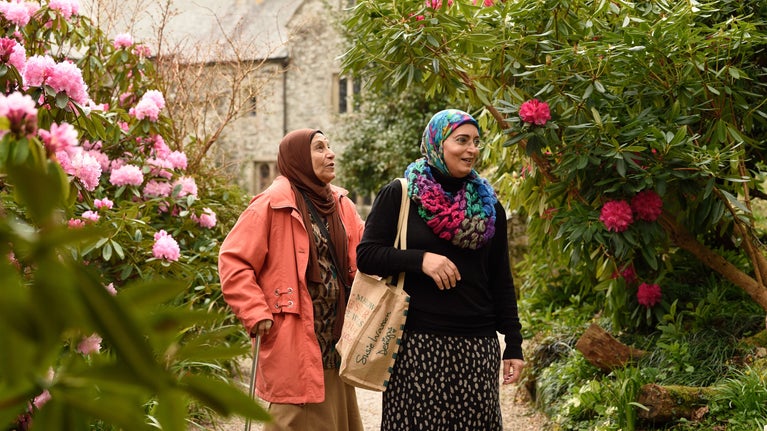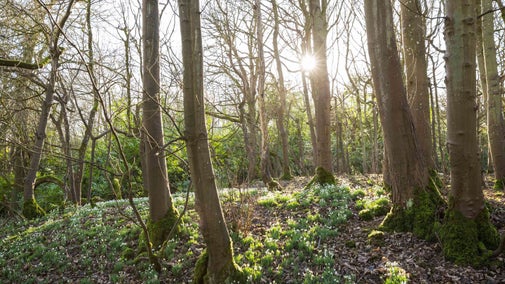
Discover more at Cotehele
Find out when Cotehele is open, how to get here, the things to see and do and more.

Open from dawn to dusk, the Cotehele estate boasts 526 hectares (1,300 acres) of woodland and fields where you can find all sorts of flora and fauna. Look out for the historic chapel in the woods, the resident bats and the views from the 18th-century Prospect Tower. Plus, the grounds are home to Cotehele Quay, which was once a bustling Victorian wharf.
You'll find the Chapel in the Wood overlooking the river at the bottom of the Valley Garden. It marks the spot where Sir Richard Edgcumbe, the 15th-century courtier, made a narrow escape from King Richard III’s men in 1483.
It’s believed that the Prospect Tower was erected to commemorate King George III’s visit to Cotehele in 1789. No one knows its intended purpose, but it’s possible that the tower was built simply as an eye-catching structure that could also act as a signalling tower when needed.

The UK is reportedly home to 17 species of bat and eight of those have been found in recent surveys on the Cotehele estate. They tend to roost in hollowed trees, the eaves of holiday cottages and limekilns on Cotehele Quay. Colonies of lesser horeshoe bats also roost in some of the house’s chimneys.
Other species that have been recorded at Cotehele include pipistelle, noctule, natter’s and daubenton’s. Daubenton’s are also known as ‘water bats’ and can be seen catching insects from the water’s surface.
Bats hibernate over the winter, which helps them save energy at a time when it’s cold and there’s less food available. Spring, however, is a busy time for the small flying mammals. They come out of hibernation around March and April, both hungry and active.
They busy themselves hunting for insects and, by May, the females are roosting in maternity colonies, preparing to have their pups.
Spring is the best time to spot bats, particularly while they’re out hunting in the early evening. As the days get longer into the summer they’ll emerge later at night.
The best place to spot bats is down on Cotehele Quay in the evening, where you can watch them swooping overhead and feeding on the river. Each species can be identified from their unique high frequency, which they emit while flying. A bat detector can help you know which bat is which from the sound it makes.

The Cotehele estate includes 111 hectares (274 acres) of mixed woodland, which is home to oak, ash, sweet chestnut, sycamore and beech trees, with an understory of hazel and holly.
Cotehele’s woodland grows on the steep sloped valley sides along the River Tamar and are extremely varied in character. There are ancient woodland sites, like Bohetherick, to old mining and gardening areas that have only been reverted to woodland in the last six or seven decades, like the Danescombe Valley.

Find out when Cotehele is open, how to get here, the things to see and do and more.
Take a stroll around the 5.5 hectares of Cotehele's garden where you’ll discover terraced herbaceous borders, a lily pond as well as a medieval stewpond and dovecote.

Dogs are welcome to join you at Cotehele. There are miles of paths and loads of space where they can stretch their legs and bowls of clean water once they’re thirsty. Cotehele is a two pawprint rated place.

Tuck into a cream tea at one of Cotehele’s cafés, find an eco-friendly gift or plant at the shop, and discover local artists at The Bull Pen Gallery.

Plan a visit to one of the special countryside places in our care and discover the benefits of being in the great outdoors. Pack your walking boots and get ready to explore woodlands, valleys and rivers.

Cornwall has a wealth of woodlands, bridleways, trails and paths to explore including a wet willow woodland. Experience fresh air outdoors with the whole family this summer and look out for an abundance of wildlife and butterflies that call this place home.

Explore some of the finest landscapes in our care on coastal paths, accessible trails, woodland walks and everything in between. Find the best places to walk near you.
